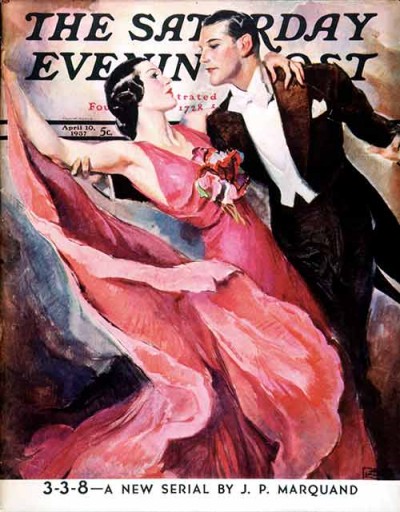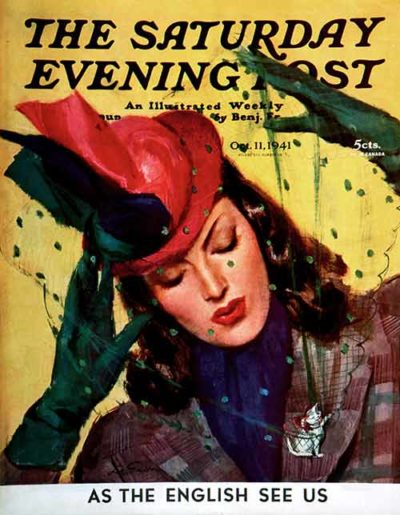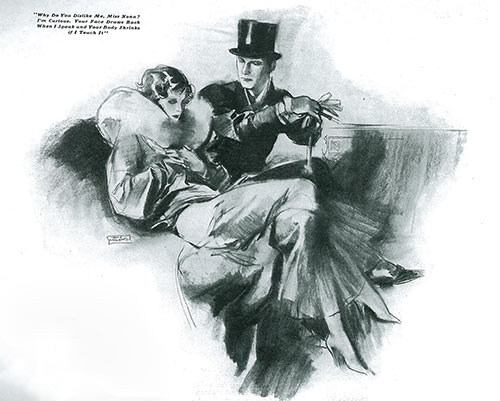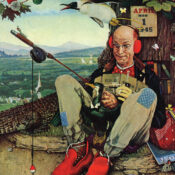“Beauty today is the world’s champion salesman, or rather sales-woman, no matter whether a strikingly short story or a box of talcum powder is the thing to be sold by an illustration.” – John LaGatta
“When Beggars Ride” by John LaGatta

“When Beggars Ride”
from January 11, 1930
In 1930, the Post was chock-full of fiction, illustrated by the finest artists of the period. This sophisticated drawing is from a six-part serial called “When Beggars Ride” by George Agnew Chamberlain.
At a young age, John LaGatta (1894-1977) came to the United States from Naples, Italy. Looking at his slinky ladies, it is difficult to believe his early art (while still a teen) in advertising often depicted working life, such as men in overalls. LaGatta went to Cleveland and joined the art studios there. He soon discovered that his true skill and passion involved painting glamour and beauty.
“Milk and Honey” by John LaGatta

“Milk and Honey”
from March 4, 1933
Thomas Beer’s fiction piece, “Milk and Honey,” ran in March of 1933 and boasted this gorgeous illustration. One is put in mind of F. Scott Fitzgerald characters in LaGatta’s illustrations: everyone is stylish and urbane. And sensual. One website describes it well: he had an uncanny ability to make “clothed women look like they were wearing virtually nothing.”
“The Wall” by John LaGatta

“The Wall”
from May 14, 1938
“Juliette standing there, tall and slim and smiling, inspecting herself. And all the time, as the clock on the mantel ticked on, her span of life growing shorter,” reads the caption from the 1938 serial “The Wall.” The story was by Mary Roberts Rinehart, a very popular writer of the era.
Just how in demand the artist was is demonstrated by this quote from another big writer of the time, Clarence Budington Kelland: “John LaGatta is a Long Island neighbor of mine who is so busy drawing pictures that I have to break into his studio to see him. He is darn near perfect, or will be as soon as he discovers how dandy it is to waste time.” The chances of that happening were slim, as LaGatta’s work was found all in or on virtually all major periodicals, such as Life and Cosmopolitan, not to mention his ad work for major clients such as Kellogg’s, Ivory Soap and Johnson & Johnson. The artist with a passion for beauty was one busy man.
“Women in Riding Habits” by John LaGatta

“Women in Riding Habits”
from January 6, 1934
This 1934 cover is typical of the over twenty Post covers LaGatta did: long, lean ladies in colorful garb. His art was a window into a world of cool elegance most readers would not otherwise be aware of.
“Ballroom Dancing” by John LaGatta

“Ballroom Dancing”
from April 10, 1937
From 1937, this gorgeous cover fits in with today’s resurgence of ballroom dancing.
In a “Keeping Posted” piece in an issue from 1938, author Kelland further dishes about his fellow Post contributor, the artist. “Mr. LaGatta…is addicted to tea and cinnamon toast at about five o’clock, afternoons, and he does not believe authors are good for anything but to furnish raw material for illustrators to illustrate.” Post editors mused that if LaGatta wanted to get revenge “for this across-the-fence interview he can draw a picture” of his neighbor “in either a bathing suit or a picture hat. We won’t promise to print it.”
“Cat Pin” by John LaGatta

“Cat Pin”
from October 11, 1941
Stunning color palette. This 1941 cover is the last one La Gatta did for The Saturday Evening Post. The netting from the lady’s hat is entangled with her cat pin.
As the war years came upon America in the 1940s, the need for romantic illustration waned. Tired of the rigors of New York life, LaGatta moved to California. Although he continued his advertising regimen, he began to extend his interest to portrait commissions and teaching. In 1956, LaGatta was invited to join the faculty of the Art Center School. For nearly 21 years, he inspired the next generation of illustrators to hone their talent. He was known as a strict taskmaster from “the old school” but those that put in the effort were not sorry. He taught and worked until his death in 1977.
Become a Saturday Evening Post member and enjoy unlimited access. Subscribe now




Comments
Very interesting article. Mr. LaGatta was an excellent artist and had a very full life. I thank you for letting me know more about him, and to see some of his non-cover work.
Diana, I love your feature in this week’s e-mail. Although I know the POST re-ran the ‘Ballroom Dancing’ cover a few years ago, so I technically was familar with LaGatta’s work, but not the broad range of his style.
No doubt the people in ‘Milk and Honey’ were among the well-to-do in ’33—one of the worst years of the Depression, bur we leave that aside to concentrate on the beauty of this European-style, yet completely American water color that yes, did leave the women kind of, sort of, looking unclothed. I like that though. It also has a ‘Gatsby’ feel to it, but it’s also definitely past the ’20s and before the ’40s. Gorgeous cover!
The ‘Riding Habits’ cover is beautiful too—love the car! I’m sorry the ‘Cat Pin’ cover did NOT come up, but the description did. I’ll see it at some point I’m sure.